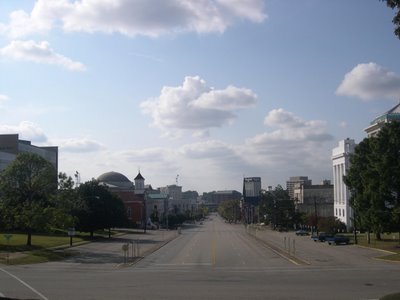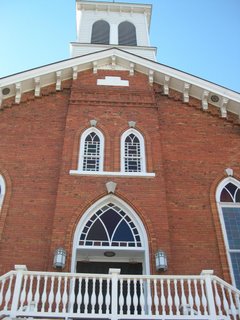
Tony Horwitz wrote “Confederates in the Attic” about a 10-state journey across the South where he gives the reader an insightful as well as funny look at the place I call home. Turn to pages 352-359 in the paperback version for a picture of Montgomery. Horwitz observed, “I wondered if the “We’re History” sign was meant to be read literally.”
 The city’s state workers clear out of town after five and the city becomes “a virtual ghost town.” That’s changing. Since he wrote this, a new baseball stadium has been built for the minor league Montgomery Biscuits, and the skeleton of the new civic center building rises day by day. South Korean automaker Hyundai built a plant on the outskirts of town.
The city’s state workers clear out of town after five and the city becomes “a virtual ghost town.” That’s changing. Since he wrote this, a new baseball stadium has been built for the minor league Montgomery Biscuits, and the skeleton of the new civic center building rises day by day. South Korean automaker Hyundai built a plant on the outskirts of town.But he’s right about the rest. The way people here view education is a lot like Horwitz’s conversation with a home-schooling parent who said of slavery, “That was a period of history, that’s all. You can’t gloss it over. But teach the truth. Public schools won’t do it.”
 I have been writing about this lately. Montgomery again struggles with an issue with racial undercurrents although those who want our superintendent of education fired adamantly insist that it’s competency. Maybe it’s both. Couldn’t that be it? Dr. Carlinda Purcell failed to crack Montgomery’s “Good Ole Boy” network and had trouble from the start. Now it’s too late, and she’ll most likely walk away with a big settlement. But what happens after she leaves. How will the city deal with this issue which goes back to the early days of desegregation when whites started pulling their kids out of public schools and putting them into private schools? In their hearts and minds and with their pocketbooks they abandoned public education. Dr. Purcell may leave, but we are still stuck with that legacy.
I have been writing about this lately. Montgomery again struggles with an issue with racial undercurrents although those who want our superintendent of education fired adamantly insist that it’s competency. Maybe it’s both. Couldn’t that be it? Dr. Carlinda Purcell failed to crack Montgomery’s “Good Ole Boy” network and had trouble from the start. Now it’s too late, and she’ll most likely walk away with a big settlement. But what happens after she leaves. How will the city deal with this issue which goes back to the early days of desegregation when whites started pulling their kids out of public schools and putting them into private schools? In their hearts and minds and with their pocketbooks they abandoned public education. Dr. Purcell may leave, but we are still stuck with that legacy.(Photos of Jeff Davis and downtown Montgomery by Scott Noblitt. I took the one of Dexter Avenue King Memorial Baptist Church)
No comments:
Post a Comment